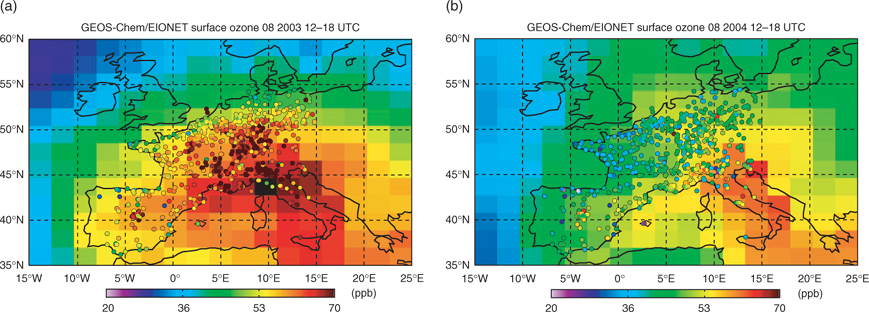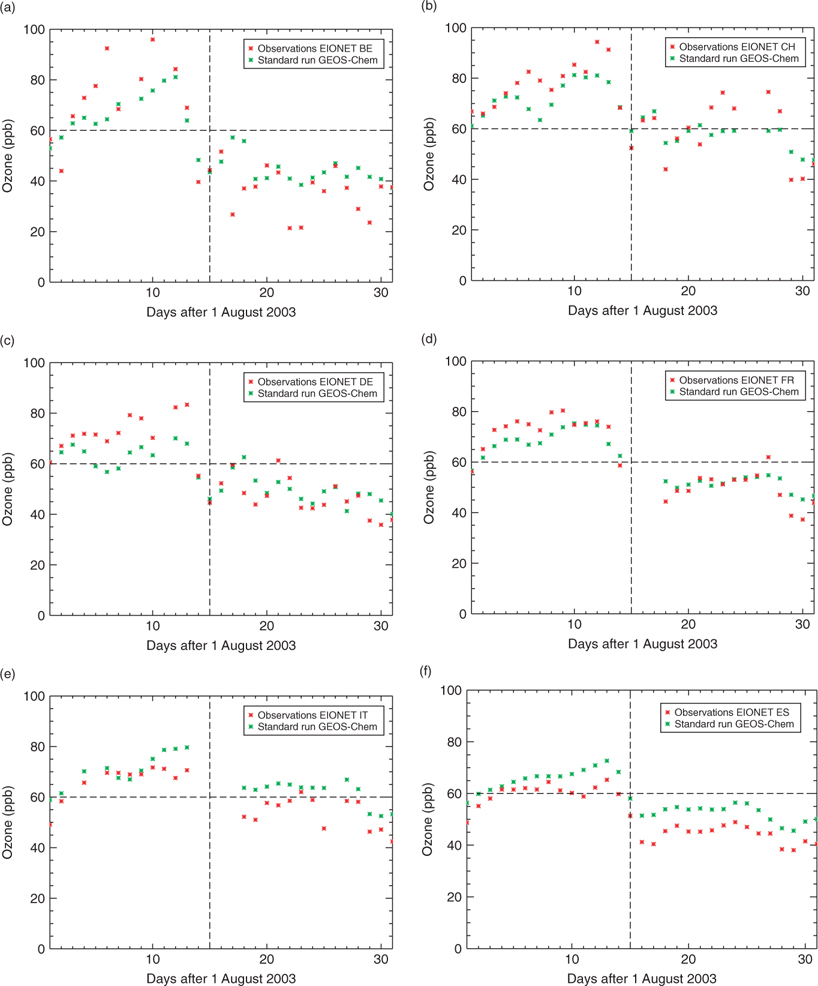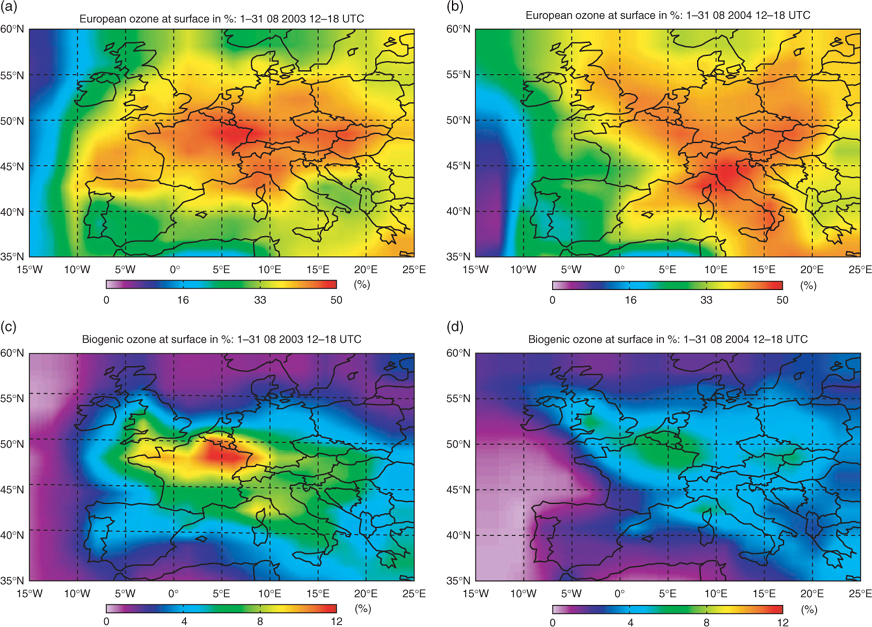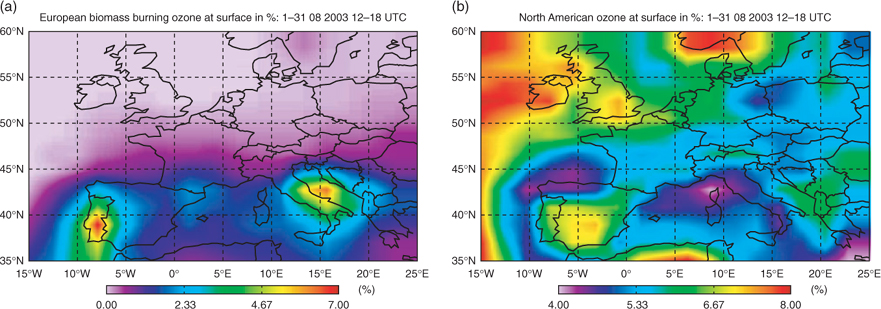A global model study of ozone enhancement during the August 2003 heat wave in Europe
G. Guerova A B C and N. Jones AA Centre for Atmospheric Chemistry, University of Wollongong, Wollongong, NSW 2522, Australia.
B Laboratoire de Modélisation de la Chimie Atmosphérique, EPFL Lausanne, Switzerland.
C Corresponding author. Email: guergana@uow.edu.au
Environmental Chemistry 4(5) 285-292 https://doi.org/10.1071/EN07027
Submitted: 20 March 2007 Accepted: 25 September 2007 Published: 2 November 2007
Environmental context. During the 2003 European summer, record high temperatures were measured and some regions experienced 14 consecutive days with maximum temperatures above 35°C, thus triggering a heat wave. The prolonged heat and strong insolation facilitated the build up of exceptionally long-lasting and spatially extensive episodes of high ozone concentrations close to the surface. Ozone is a very reactive pollutant with known effects on both human and vegetation health. It is important to build robust models that can predict its concentration in a similar manner to which weather prediction models operate.
Abstract. The European summer of 2003 was characterised by intense heat, prolonged isolation and suppressed ventilation of the boundary layer which, combined with large anthropogenic emissions and strong fires, resulted in a build up of an unprecedentedly high and long-lasting photochemical smog over large parts of the continent. In this work, a global chemistry and transport model GEOS-Chem is compared with surface O3 concentrations observed in 2003 in order to examine the extent to which the model is capable of reproducing such an extreme event. The GEOS-Chem reproduces the temporal variation of O3 at the Jungfraujoch mountain site, Switzerland, including the enhanced concentrations associated with the August 2003 heat wave (r = 0.84). The spatial distribution of the enhanced surface O3 over Spain, France, Germany and Italy is also captured to some extent (r = 0.63), although the largest concentrations appear to be located over the Italian Peninsula in the model rather than over Central Europe as suggested by the surface O3 observations. In general, the observed differences between the European averaged O3 concentrations in the summer of 2003 to those in 2004 are larger in the observations than in the model, as the model reproduces relatively well the enhanced levels in 2003 but overestimates those observed in 2004. Preliminary contributions of various sources to the O3 surface concentrations over Europe during the heat wave indicate that anthropogenic emissions from Europe contribute the most to the O3 build up near the surface (40 to 50%, i.e. 30 ppb). The contribution from anthropogenic emissions from the other major source regions of the northern hemisphere, in particular North America, tends to be smaller than those of other years. The model indicates that the large fires that occurred in that year contributed up to 5% (3 ppb) to surface O3 in close proximity to the fire regions and less elsewhere in Europe. Biogenic volatile organic compounds (VOCs) emitted by grass and forest areas contributed up to 10% (5–6 ppb) of surface O3 over France, Germany and northern Italy, which represents a contribution that is twice as large than that found in 2004. These results in terms of contributions from various sources, particularly biogenic emissions, should be seen as preliminary, as the response of vegetation to such extreme events may not be well represented in the model.
Additional keywords: chemical weather, global chemistry, model simulations, photochemical smog.
Introduction
During the first half of August 2003, record high temperatures were measured in west, central and south Europe: UK, the Netherlands, France, Germany, Switzerland, Italy and some regions experienced 14 consecutive days with maximum temperatures above 35°C.[1] According to Schaer and Jendritzky,[2] the mean summer temperature in Switzerland was on average 3°C higher than the 1961–1990 mean, which corresponds to an excess of up to five standard deviations. The unusually high temperatures were associated with persistent anticyclonic blocking which triggered a heat wave. It was suggested that this prolonged heat wave may be a manifestation of an exceptional northward extension of the Hadley Cell.[3] In summer, the atmospheric circulation over Europe is controlled by the Azores anticyclone, its north-easterly extension and its retreat. The European storm track associated with the Icelandic cyclone is less intense and the reduced air mass contrasts produce weaker fronts. The heat wave summer of 2003 was associated with an extension of the Azores anticyclone over large areas of Europe, i.e. Spain, France, Germany, Switzerland and Italy, and its persistence of ten or more days in August 2003. This type of synoptic large-scale circulation is characterised by stable weather conditions, blue sky and intense sun light.
The stagnant weather, prolonged heat and strong insolation facilitated the build up of exceptionally long-lasting and spatially extensive episodes of high O3 concentrations close to surface.[4] According to Fiala et al.[4] the European information threshold was exceeded over a much larger area in summer 2003 than in previous summers. The ‘information threshold’ is an hourly average O3 concentration of 90 ppb beyond which there is a risk to human health from brief exposure for particularly sensitive sections of the population and at which up-to-date information is necessary. More than ten days that exceeded the 90 ppb threshold were observed in south-western Germany, Switzerland, northern and south-eastern France, Belgium, northern and central Italy, and central Spain. In France, the average number of hours per station that O3 exceeded this information threshold was one third higher compared with 1994, another year with a warm summer.[4] The reported daily O3 maxima in Switzerland were on average 15 ppb higher in 2003 when compared with the summers of 1992–2002. The Swiss air quality O3 standard, which is an hourly mean of 60 ppb, was exceeded by up to 700 h in the summer of 2003, i.e. more than twice the previous years according to Ordonez et al.[5]
In 2003, many regions of Europe experienced drought conditions and the annual precipitation deficit in Europe was reported to be 50% below the average.[6] The 2003 drought had severe impacts on fire regimes. For example, in July and August 2003, intense fires occurred in southern Europe that included France, Spain and Portugal, sweeping through 5.6% of the national forest area and causing losses of ~1 billion euros.[7] The vegetation response to oxidative stress was observed with abnormal changes in the colour of the leaf tissue and early leaf loss (Dr. P. Vollenweider pers. comm.).
The two weeks of prolonged heat and poor air quality in August 2003 is referred to as one of the ten deadliest natural disasters in Europe for the last 100 years and the worst in the last 50 years.[1] A death toll of ~30 000 was registered as a consequence of the heatwave. In France alone, an estimated 15 000 deaths were reported.[1,8] In Switzerland, an increase of 7% (1000 deaths) was reported[9] and in the UK the estimated increase was reported to be 10–40%.[10]
The regional climate model simulations suggest that by 2100 every second summer could be as warm or warmer (and as dry or dryer) than 2003.[2] Over the past decades, global atmospheric chemistry and transport models have become useful tools for studying the interplay between meteorology and air pollution associated with large-scale circulation in the mid latitudes.[11,12] In the emerging field of ‘chemical weather’[13] the global chemistry and transport models could play an important role provided they demonstrate skill in reproducing the photochemical smog build up. Therefore, the 2003 heat wave represents a very valuable case study and the purpose of this paper is to first, test the skills of the state-of-the-art global chemistry and transport model GEOS-Chem[14] to simulate the enhanced ozone concentrations as well as ozone build up observed in August 2003, and second, to evaluate the relative contributions of the anthropogenic and natural emission sources by model sensitivity simulations. The model simulations for August 2003 are contrasted with August 2004, which presents an ‘average’ year following the O3 anomalies study by Koumoutsaris et al.[15] The 2004 European summer was not marked by extreme meteorological conditions but severe fires occurred in North America in July[16] that perturbed the European troposphere increasing the O3 burden (surface –300 hPa) by ~2–3%.[17] The paper is organised as follows. ‘Datasets’ present the surface O3 observations used in this study, including data from the mountain site, the Jungfraujoch (JFJ, Switzerland), and data from the European Environment Information and Observation Network (EIONET). The GEOS-Chem model setup is described in ‘Model description and simulations set-up’. The model evaluation is described in ‘Ozone distribution in August 2003’. The impact of different O3 contributions is examined in ‘Sensitivity simulation for heat wave O3 contributions’.
Datasets
Surface observations of O3 at the Jungfraujoch
O3 measurements at the JFJ were performed with a UV absorption instrument with an estimated standard uncertainty for hourly averages of 2% for values greater than 60 ppb (http://gaw.kishou.go.jp/wdcgg.html/, accessed 15 May 2007). The JFJ site is in the Swiss Alps at an altitude of 3580 m above sea level (asl) and is surrounded by industrialised regions. The JFJ is situated in the free troposphere (57% of the time) and is influenced by planetary boundary layer (PBL) air,[18,19] especially during the warmer months. The wind direction is influenced by the north–east–south–west orientation of the alpine watershed, which results in an average annual wind frequency of 60% from the north-west and 30% from the south-east.[18]
EIONET data
The European Environment Information and Observation Network (EIONET) is supported by the European Environmental Agency (EEA) and provides measurements of atmospheric trace gas and aerosols to the European Community member states.[4] The European air quality monitoring network includes a selection of existing stations from all countries of the European Union, as well as EEA member countries and some candidate countries that are reliable and can be compared at the European level. During the 2003 summer season, a total of 1805 O3 monitoring stations were operational mainly in the urban environment (857 stations) and rural areas (497 stations).[4] Note that only the EIONET stations classified as rural and suburban are used in this study. The total number of stations is 743 in August 2003 and 697 in 2004. For model intercomparisons performed in ‘Ozone distribution in August 2003’, first the afternoon averaged station concentration and corresponding GEOS-Chem grid concentration are taken, and from this the country average is calculated.
Model description and simulations set-up
In this manuscript, we use the global three-dimensional chemistry and transport model GEOS-Chem version 7-04-06 with a horizontal resolution of 2° latitude by 2.5° longitude and 30 vertical levels from the surface to 0.01 hPa (http://www.as.harward.edu/chemistry/trop/geos/, accessed 15 May 2007). The model is driven by meteorological fields provided by the NASA Global Circulation Model GEOS-4 with a temporal resolution of 3 and 6 h. Online chemistry with 43 tracers provides a comprehensive description of the NOx–Ox–hydrocarbon chemistry and of tropospheric aerosols, which include nitrate–ammonium–sulfate aerosols, mineral dust, sea salt, black and organic carbon, and secondary organic aerosols. A total of 350 chemical reactions are taken into account in the chemical mechanism for ~90 different species, as described in Park et al.[20] The photolysis rates are calculated with the Fast-J algorithm which accounts for clouds and aerosols.[21] Dry deposition velocities are computed following Wesely[22] and Wang et al.[23] Wet deposition is applied to gases, dust and hydrophilic aerosols as described in Liu et al.[24]
The inventory of anthropogenic emissions of NOx, CO, hydrocarbons and sulfur are from the Global Emissions Inventory Activity (GEIA) for 1985[25] with updated national emissions inventories[14] and scaled for specific years.[14,20] Over Europe, North America and northern Mexico, anthropogenic NOx, CO, hydrocarbon and sulfur emissions are taken from the European Monitoring and Evaluation Program (EMEP) for the year 2000,[26] the EPA National Emissions Inventory (NEI99) for the year 1998[11,20] and BRAVO.[27] Biomass burning emissions are from the Global Fire Emissions Database GFED2,[28] and biogenic emissions are calculated online using the MEGAN algorithm described by Guenther et al.[29]
GEOS-Chem has been the subject of numerous global and regional evaluations that demonstrate the model skill in reproduction of the general features of tropospheric chemistry. In particular, Auvray and Bey[11] present an evaluation of modelled O3 over Europe, using surface observations from the EMEP network, vertical profiles from ozonesondes, and the MOZAIC program. They found that the model reproduces O3 over Europe but overestimates the observed surface concentrations at some sites in summer. This overestimation was found to be pronounced at some coastal sites where NOx dilution within the model grid box would be critical.
Presented here are the results from a standard simulation that follows the set up described above for August 2003 and 2004 obtained after a one-year spin-up. A series of sensitivity simulations were conducted with European or North American anthropogenic emissions, European biomass burning emissions or European biogenic isoprene emissions turned off successively (Table 1). Subtraction of the results from each of the sensitivity simulations from those of the standard simulation allows us to quantify the fraction of O3 solely a result of a specific O3 precursor source. Because of non-linearity in the O3 tropospheric chemistry, one has to be cautious when interpreting the results of the sensitivity simulations. It has been suggested in previous works[11] that this non-linearity can reach 10% of the total O3 burden in the boundary layer during summer. Despite this limitation, the method provides useful information on the relative contribution of various sources.

|
Ozone distribution in August 2003
Fig. 1 shows observed and simulated daily averaged O3 concentrations for August 2003 and 2004 at JFJ, along with the simulated European anthropogenic and biogenic O3 contributions. The simulated O3 closely follows the observed, and in particular, it reproduces well the enhanced concentrations observed in the first half of August 2003 that are associated with the heat wave (r = 0.84, Table 2). The observed monthly averaged O3 concentrations in 2003 are 67 ppb, i.e. ~10 ppb higher compared with 2004 (Table 2) and the model finds an average difference of ~7 ppb between 2003 and 2004. The model underestimates the observed concentrations by 3 to 5 ppb in the second half of August 2003 and in August 2004, which is probably a result of the lack of representation of the local transport in the coarse model grid. Note, however, that the underestimate of 3–5 ppb found in the present study is smaller than that reported in Guerova et al. (2006) (9 ppb, 15%) because the EMEP emissions are used over Europe in the present study, which significantly improves the simulation of surface O3 concentrations as also reported by Auvray and Bey[11] for the year of 1997.
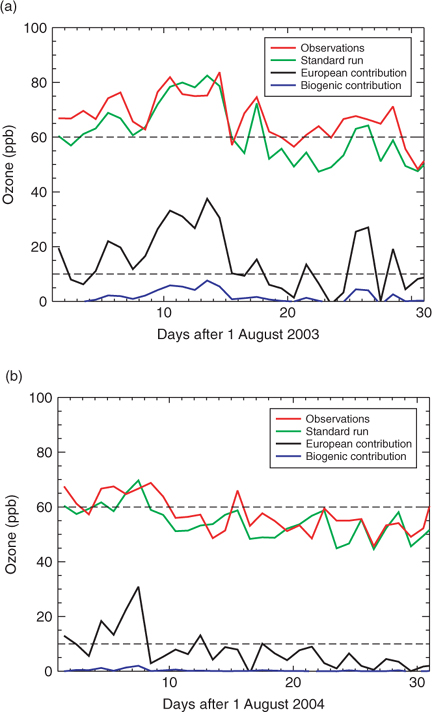
|

|
Fig. 2 compares the afternoon monthly mean (1200–1800 Coordinated Universal Time (UTC)) surface O3 from GEOS-Chem and from EIONET in August 2003 and 2004. The model slightly overestimates the observed concentrations for these two months, especially in the stations located on the western coast of Europe, which receives cleaner air from the North Atlantic Ocean. This is likely related to the treatment (i.e. smoothing) of anthropogenic emissions in the rather coarse horizontal grid of the model, which leads to an artificial increase in O3 production. Simulated O3 concentrations are also higher above the Italian Peninsula and the surrounding area. The simulated domain-averaged O3 concentration is 58.4 ppb in August 2003, in good agreement with the observed value of 57.5 ppb. In contrast, the observed monthly averaged O3 is 43.7 ppb in 2004, i.e. ~14 ppb less than in 2003. The model also simulates smaller concentrations in 2004 (51 ppb), although the differences between the two summers are larger in the observations than in the model. Under the conditions of the persistent anticyclonic blocking in summer 2003, the air masses aged more efficiently than during a ‘normal’ summer, and the ‘artificially’ enhanced mixing of O3 precursors in the model grid box become closer to reality, which may explain, to some extent, the good agreement found in 2003. It is found that the model has some success in reproducing the spatial distributions of the enhanced concentrations observed during the heat wave of 2003 (correlation of 0.63, Table 3), although the larger concentrations appear to be observed in Central Europe, whereas they are found over the Italian Peninsula in the model.

|
In order to test the ability of the model to reproduce temporal variation of afternoon (1200–1800 UTC) surface O3 in August 2003, the EIONET observations are averaged on a country-by-country basis and plotted against the simulated concentrations (Fig. 3). Fig. 3a presents the O3 build up over Belgium. During the first half of the month, the simulated O3 shows a steady increase starting from ~50 ppb on 1 August and reaching 80 ppb on 13 August. After 13 August, a reverse trend is seen. The observed O3 has much higher temporal variability starting from 55 ppb on 1 August and reaching 90 and 100 ppb on 10 and 11 August, respectively. The model tends to underestimate the O3 in the first half of the month (the bias is –6.5 ppb and correlation 0.86) and overestimate it in the second half of the month (the bias +9.3 ppb and no correlation). The surface O3 over Switzerland (Fig. 3b) shows an increase up to 5 August, dips in the following three days and then levels off at ~80 ppb between 9 and 13 August. The model represents the temporal variation over Switzerland very well and shows a tendency to underestimate the O3 in the first half of the month by –5.1 ppb. The same is valid over Germany (Fig. 3c) where the model underestimation in the first half of the month is –8.0 ppb and the bias reaches –10 ppb on particular days. The ability of the model to represent the temporal variation at the surface is best over France (Fig. 3d). The averaged O3 in the first half of August has levelled at 75 ppb, which contracts to the 55 ppb levelling off in the second half of the month. The model underestimates the O3 in the first half of the month by –3.9 ppb, with a correlation of 0.85, in comparison to the second half where the model overestimates the O3 by 2 ppb and the correlation is 0.82. Over Italy and Spain (Fig. 3e,f), the model consistently overestimates the O3 concentration by 4.4 and 5.6 ppb, respectively, with correlation coefficients of 0.78 and 0.83, respectively, in the first half of the month.
As temperature is the one of the driving factors in O3 formation during the heat wave, we compared the mean afternoon surface temperature from GEOS-Chem with two stations in Switzerland (Basel and Geneva), where record high temperatures were measured in August 2003. Between 3 and 13 August the observed temperature reached 35°C, and then dropped to 25°C on 15 August. While the temporal variation is well represented by the model, the correlation is 0.93 and 0.97, respectively, the simulated afternoon temperature is underestimated by 6.0°C for Basel and 4.0°C for Geneva. This underestimation is to be taken with caution, as the coarse model resolution does not resolve both the local effects and the topography.
Sensitivity simulation for heat wave O3 contributions
Time series of the different contributions at the JFJ (Fig. 1) reveal a particularly marked contribution from European sources during the first half of August 2003. This likely reflects the enhanced depth of the PBL that was observed during that summer over Central Europe, which facilitates the arrival of local O3 precursors from the surrounding industrial regions to the mountain top. In the first half of August, the simulated PBL height at 1600 UTC was on average 2340 m asl, while it reaches only 1580 m in the second half of the month. The monthly averaged European anthropogenic contribution at JFJ is 17.8 ppb (29%) in August 2003 v. 7.5 ppb (16%) in 2004. The biogenic contribution (blue line in Fig. 1a) is 2 ppb (3%) in August 2003; however it has significant temporal variation, and in the second week, it is well above 5 ppb. For comparison, in August 2004 the biogenic contribution is negligible (blue line in Fig. 1b).
The model sensitivity simulations (Fig. 4a) show that the contribution from regional anthropogenic emissions is up to 50% (30 ppb) over large parts of Europe, i.e. France, Germany, Switzerland, and northern Italy, in August 2003. The contribution of biogenic isoprene emissions (Fig. 4c) to the near surface O3 burden in August 2003 is the second largest, close to 10% (5–6 ppb), which presents a doubling of the biogenic O3 enhancement seen in 2004 (Fig. 4d). It should be noted that in August 2003, the GEOS-Chem biogenic isoprene emissions over Europe were 5.54 Tg N, which presents a 40% increase compared with August 2004 emissions of 3.68 Tg. The monthly mean surface isoprene concentrations observed at three stations in France (http://www.nilu.no/projects/ccc/emepdata.html/, accessed 15 May 2007) were 1.9 ppb in August 2003 and 1.0 ppb in August 2004, while the simulated concentrations are 2.1 and 0.9 ppb, respectively. Additional simulations were conducted to evaluate O3 enhancements from the intense fires in southern Europe. The averaged European biomass burning CO emissions in GEOS-Chem for August 2003 are 1.19 Tg C against 0.48 Tg C in 2004. The resulting enhancement (Fig. 5a) is up to 5% (2–3 ppb) regionally, but has no direct impact on the O3 concentrations close to the surface in France, Germany and Switzerland. It should be noted, however, that the biomass burning emissions in GEOS-Chem are monthly resolved and it has been suggested that daily inventories are more appropriate for this type of study.[16] The enhancement as a result of long-range transport of O3 from North America (Fig. 5b) is close to 5% (3 ppb) over France, Germany, Switzerland and northern Italy. This is to be expected as the strong anticyclone that persisted over the first half of the month prevented episodic transport from North America associated with North American cyclones crossing the North Atlantic. In contrast, the contribution from long-range transport reaches 10% (5–6 ppb) over France in August 2004 (not shown).
Summary
The long-lasting heat wave in summer 2003 triggered significant O3 enhancement in large parts of west, south and central Europe with observed monthly mean surface O3 14 ppb higher compared with 2004. This work aims to test the skills of the state-of-the-art global chemistry and transport model GEOS-Chem in reproducing the photochemical smog build up in August 2003 and to provide some preliminary contributions from various sources to O3 surface concentrations over Europe.
At the high-alpine JFJ site, the observed monthly mean O3 is 67 ppb in 2003 compared with 58 ppb in 2004. The model successfully reproduces the temporal variation of O3 (r = 0.84), including the enhanced concentrations associated with the August heat wave, but the model underestimates the observed concentrations by 3 ppb. The spatial variation of the observed surface O3 enhancement over Spain, France, Germany and Italy is also captured to some extent (r = 0.63) in the model, although the largest concentrations appear to be located over the Italian Peninsula in the model rather than over Central Europe. The model shows significant skill in reproducing the day-to-day variation of the afternoon O3 build up in the first half of August, where the correlation is in the range 0.78 to 0.86, over Belgium, Germany, Switzerland, France, Spain and Italy. The model tends to underestimate the observed high O3 concentrations over France, Germany, Belgium and Switzerland, which is partly related to the model resolution which limits its capacity in representing the magnitude of observed high temperatures.
Based on model sensitivity simulations, we find that, as expected, the main contribution to the O3 build up near the surface is the anthropogenic emissions from Europe (40 to 50%, i.e. 30 ppb). The contribution from anthropogenic emissions from other major source regions of the northern hemisphere, particularly North America, tends to be smaller than those in 2004, which is probably a result of the blocking meteorological situation that does not favour episodic long-range transport of pollution. The intense heat and drought facilitated wild forest fires in Spain, Italy, France and Portugal, which destroyed 5.6% of the national forest area and emitted large amounts of gas and aerosol pollutants. Our model indicates that the fires contributed O3 concentrations to up to 5% (3 ppb) above background in close proximity to the fire regions and less elsewhere in Europe. Finally, biogenic isoprene emitted by grass and forest areas contributed up to 10% (5–6 ppb) of surface O3 over France, Germany and northern Italy, which represents a contribution that is twice as large as that in 2004.
Although the model results shown in this paper are very promising, some disagreements between observations and simulated O3 concentrations remain. Further work should be thus devoted to the simulation of this particular episode, as it represents a very valuable benchmark case for model evaluation, but also because it has been suggested that by 2100 every second summer could be as warm or warmer, and as dry or dryer, than 2003.[2]
Acknowledgement
The GEOS-Chem model is managed by the Atmospheric Chemistry Modelling Group at Harvard University with support from the NASA Atmospheric Chemistry Modelling and Analysis Program. Isabelle Bey and Daniel Jacob were very helpful in shaping the manuscript as well as discussions with G. Gurci on isoprene emissions and M. Suarez on surface temperature. The air quality network NABEL and the Swiss Agency of Environment, Forest and Landscape (SAEFL) are acknowledged for granting access to the observations at the Jungfraujoch site. We acknowledge the European Environment Agency for providing the EIONET data. We are grateful to the Australian Partnership for Advanced Computing (APAC) for significant computing resources and support. We thank three anonymous reviewers who provided thoughtful comments.
[1]
[2]
C. Schär ,
G. Jendritzky ,
Climate change: Hot news from summer 2003.
Nature 2004
, 432, 559.
| Crossref | GoogleScholarGoogle Scholar | PubMed |
[Verified 1 July 2007]
[16]
S. Turquety ,
J. Logan ,
D. Jacob ,
R. Hudman ,
F. Leung ,
C. Heald ,
R. Yantosca ,
S. Wu ,
L. Emmons ,
D. Edwards ,
G. Sachse ,
Inventory of boreal fire emissions for North America in 2004: the importance of peat burning and pyro-convective injection.
J. Geophys. Res. 2007
, 112, D12S03.
| Crossref | GoogleScholarGoogle Scholar |
[Verified 15 May 2007]
[27]
H. Kuhns ,
E. Knipping ,
J. Vukovich ,
Emissions Inventories and SMOKE modeling for the Big Bend Regional Aerosol and Visibility Observational Study.
J. Air Waste Manage. Assoc. 2005
, 55, 677.

[28]
G. van der Werf ,
J. Randerson ,
L. Giglio ,
G. Collatz ,
P. Kasibhatla ,
A. Arellano ,
Interannual variability in global biomass burning emissions from 1997 to 2004.
Atmos. Chem. Phys. 2006
, 6, 3423.

[29]
A. Guenther ,
T. Karl ,
P. Harley ,
C. Wiedinmyer ,
P. Palmer ,
C. Geron ,
Estimates of global terrestrial isoprene emissions using MEGAN (Model of Emissions of Gases and Aerosols from Nature).
Atmos. Chem. Phys. 2006
, 6, 3181.



